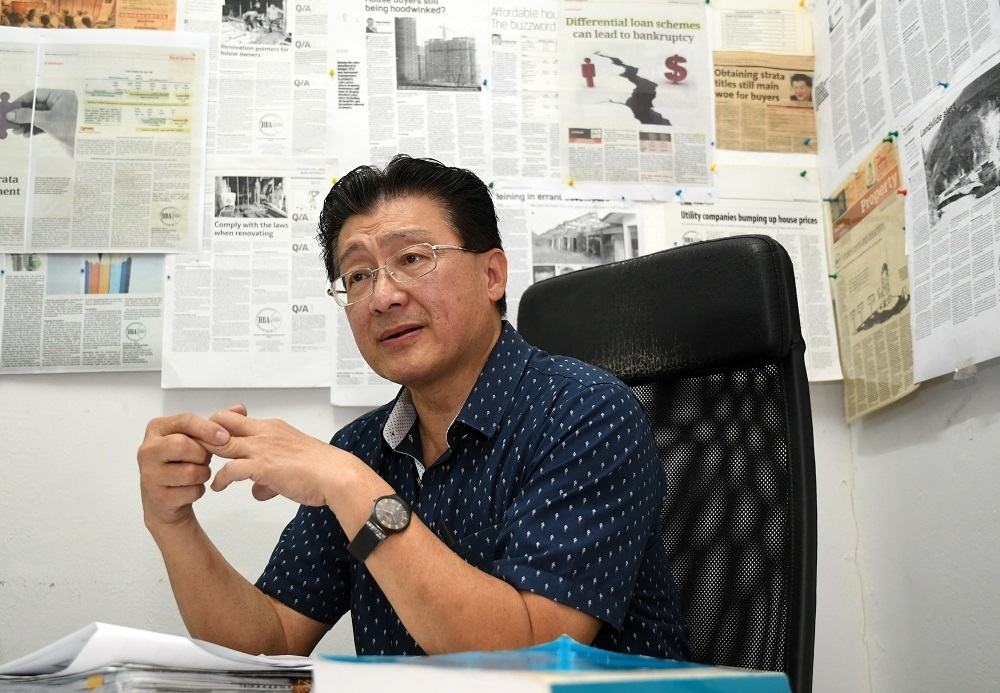
- What KL needs isn't new laws, renewal or redevelopment legislation; it needs an awakened civic consciousness, meaningful education, and robust social care.
In the heart of our capital, Kuala Lumpur, amidst gleaming skyscrapers and bustling streets, lie the forgotten shadows of dilapidated buildings: unsafe, unhygienic, and silently breeding distress. These structures are not only relics of neglect but physical reminders of our collective responsibility gone unfulfilled.
However, the solution is not to tear them down and replace them with newer, bigger, and taller buildings to house higher densities, which is what the Urban Renewal Act (URA) proposes to do.
The National House Buyers’ Association (HBA) has said enough about why the URA goes against the grain of the Federal Constitution and rights of property owners, but the question remains: how do we solve the problem of these almost inhabitable buildings?
Read also
How Urban Renewal Act proposals contravene Federal Constitution
While the Government, and even developers, wear “sustainability” like a cloak, there seems to be a double standard when it comes to the URA.
At its most basic, sustainability includes waste reduction—as long as it's repairable, don't throw. So, how could you honestly say you practise sustainability when you demolish whole buildings and dump a mountain of concrete, wood, metal, glass, and asphalt into more landfills; and then replace the site with a population density that way exceeds what the existing infrastructure can support?
No, what KL needs isn't new laws, renewal or redevelopment legislation; it needs an awakened civic consciousness, meaningful education, and robust social care.
Weak maintenance culture
Generally, Malaysia's maintenance culture is widely regarded as poor, characterised by a public and governmental tendency to prioritise new construction over upkeep, leading to neglected public infrastructure like buildings, parks, and transport systems. This culture is marked by complacency, reactive “knee-jerk” fire fighting rather than preventive maintenance. Furthermore, a lack of accountability also results in deteriorating facilities and safety hazards.
Key factors contributing to this issue include insufficient funding, weak leadership, a lack of comprehensive policy systems, inadequate training, and a widespread “this is not my job” attitude, according to research and public opinion.
The urban decay we overlook
A broader perspective also reveals that two-thirds of Malaysia’s old buildings are projected to remain in use until 2050, even if they fail modern safety, energy, and building standards; signalling the urgency for refurbishment and modernisation.
As of February, KL City Hall (DBKL) identified 48 abandoned premises and buildings across the city: 25 residential and 23 commercial. These structures are not confined to the city’s periphery; they stand in high-potential locales such as Kampung Baru, Taman Tun Dr Ismail, Setapak, Cheras, and Kampung Pandan. Even core areas including Jalan Bukit Bintang, Jalan Pudu, Jalan Ipoh, and Lorong Tiong Nam are tainted by neglect.
In Bukit Bintang, a dilapidated, unhygienic building; possibly housing foreign workers, stands next to tourist hot spots like Jalan Changkat and a mural art lane. Tenants reportedly pay RM600/month to live amidst trash, smell, and structural danger.
Another particularly distressing example is the Kuchai Jaya Flats in Jalan Kuchai Lama. Built in the 1980s, these blocks suffer leaking sewage, cracked walls, clogged drains, and dark, unsafe corridors. At night, some empty blocks become havens for criminal activity: drug dens, squatting, and tragedy have all been reported.
Notably, the Housing and Local Government Minister Nga Kor Ming, with some members of parliament, did visit this site and promote it as one that required prompt “renewal and redevelopment” aka demolition and rebuilding.
However, on Oct 12, HBA has mobilised a team of expert volunteers to explore refurbishing this flats, including repainting, replacement and repair of roof, lightings, water downpipes, and unclogging of drains, as well as removing the “Jumanji”-like overgrowth, and together with the residents, to carry out a gotong-royong to clean up the place, to prove that old buildings can be given a new lease of life without levelling it to the ground.
Why laws and redevelopment alone won’t suffice
DBKL has leveraged legal frameworks; issuing notifications under Sections 74 and 75 of the Local Government Act 1976 (Act 171), and Section 83(1) of the Roads, Drainage and Buildings Act 1974 (Act 133), to compel building owners to repair or clean up unsightly and unsafe structures. Yet, out of 48 identified owners, only nine have taken action.
The Kuala Lumpur Local Plan (KLLP) 2040 identifies 139 sites for redevelopment, including old public housing like PKNS flats along Jalan Kuching and Wangsa Maju sections 1, 2, and 4. These plans, while ambitious, often hit stumbling blocks: layered ownership, heritage planning restrictions, unanimous-consent requirements, and community mistrust all hinder redevelopment.
The proposed URA seeks to ease this by lowering the redevelopment consent threshold to 75% or 80% for buildings deemed dilapidated, but this threatens to introduce dissension into what would have once been a harmonious community.
Furthermore, legislation alone cannot solve what is essentially a social issue. Redevelopment without compassion risks displacing the very people it aims to help.
Read also
Urban Redevelopment Act forum: Don’t wage war between ‘sell’ and ‘stay’ homeowners
The social gaps underneath physical decay
These physical wounds of the city are symptoms of deeper social neglect. Residents in rundown buildings, often elderly, low-income, or socially isolated, face daily indignities. Their children may be vulnerable to crime; and the buildings themselves may lack proper fire exits, safe water, or pest control.
Redevelopment that doesn’t centre residents runs the risk of displacement without dignity. The past efforts, such as the 1 Razak Mansion project in Salak South and Residensi Kerinchi in Bangsar South, showed that community engagement can work—original residents moved to more comfortable 800 sq ft units near improved amenities after sessions of negotiation and with 100% consensus.
The stark contrast between their former harsh living conditions and what’s possible underscores the need to shift focus, from merely building anew, to re-building trust.
Civic-consciousness: the foundation we need
What can bridge the gap between law and humane progress is civic consciousness. This means:
- Empowering residents through awareness campaigns about their rights and responsibilities
- Encouraging neighbourhood-led cleanliness drives or block watch programmes
- Promoting community reporting systems that make it easier to flag unsafe or unhygienic conditions (and rebuild trust in reporting)
- Celebrating successful stories like 1 Razak Mansion and Residensi Kerinchi, as models of how engagement and mutual understanding make redevelopment collaborative; not coercive, not misleading, not disunity and not creating mistrust
- Management bodies and owners’ associations to bring harmony and to achieve participation and duty to take turns to serve, on a voluntary basis, in residents’ associations, joint management bodies and management corporations in stratified developments.
Education: informing hearts and minds
Beyond infrastructure, KL needs an educational turn:
- Schools and neighbourhoods should embed simple civic lessons, like proper waste disposal, shared cleanliness, and respect for common spaces into everyday life. Start them from young in kindergarden and primary schools.
- Public campaigns (via social media, local newspapers, and telecasts) can spotlight both the dangers of neglect and the benefits of upkeep.
- Mandatorily enforce the law on recycling and proper disposals.
- Workshops for landlords and building managers can equip them with knowledge on maintenance, enforcement processes, and tenant welfare.
- People must understand their role in maintaining healthy living environments, not just for themselves, but for their neighbours as well.
Social care: caring for those behind walls
Finally, no initiative is complete without social support:
- Recognise that residents in dilapidated dwellings are often vulnerable; elderly, low-income, immigrants, or families with young children. Support must be human-centric, not only structural.
- Social services: local councils, NGOs, management bodies and owners bodies should conduct regular check-ins, offer assistance in minor repairs, and help facilitate safe spaces for coordination.
- Where displacement is inevitable, ensure adequate compensation, replacement housing, and financial assistance for maintenance, just as 1 Razak Mansion did with its community facilities.
Infrastructure with integrity
The issue with run-down buildings isn't just about outdated infrastructure. It's about the dilapidated and unhygienic conditions that directly affect the wellbeing of owners, residents and occupants.
While redevelopment laws like the URA focus on structural renewal, they often overlook the deeper, human aspects of the problem. What we truly need is not just legal or bureaucratic action, but a stronger sense of civic consciousness, maintenance culture, better public education, and a commitment to social care. Lasting improvement begins not just with demolishing walls, but with building responsibility, awareness, and compassion within our communities. The government should prioritise real rejuvenation and revitalisation, and not resort to demolition and rebuilding that will suffer densification.
Without civic consciousness, education, and social empathy, we risk building shiny multiple stories of new spaces vide redevelopment laws, which will eventually be bogged by the same neglect.
Redevelopment should not be merely in the form of “brick-and-mortar”, but as human renewal—where residents are empowered, neighbours care, and every building tells a story of dignity and shared accountability. If we can revive structures with this ethos, we will truly be building a smarter, kinder capital.
This article is written by Datuk Chang Kim Loong, honorary secretary-general of the National House Buyers Association (HBA).
HBA is a voluntary non-government and not-for-profit organisation manned wholly by volunteers.
HBA can be contacted at:
Email: [email protected]
Website: www.hba.org.my
Tel: +6012 334 5676
The views expressed are the writers’ and do not necessarily reflect EdgeProp’s.
Does Malaysia have what it takes to become a Blue Zone, marked by health and longevity? Download a copy of EdgeProp’s Blueprint for Wellness to check out townships that are paving the path towards that.





